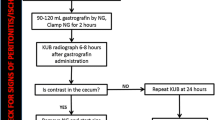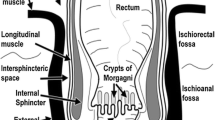Abstract
The predictive value and safety of early postoperative radiological assessment of colorectal anastomotic integrity is controversial. In this study, 233 patients with colorectal or left sided colonic anastomoses had water soluble contrast enemas performed in the early postoperative period (mean: day 7 postoperatively, range: days 4–14). A total of 40 radiological leaks were recorded but only 12 of these patients had clinical signs of anastomotic dehiscence. Furthermore, 11 patients who had normal contrast enemas subsequently developed a clinical anastomotic leak. There were therefore 28 (12.0%) false positive and 11 (4.7%) false negative results giving values for the specificity and sensitivity of the radiological investigation of 86.7% and 52.2% respectively. Only 3 patients (1.3%) developed a clinically apparent anastomotic complication following a contrast enema. We conclude that while radiological assessment of distal large bowel anastomoses in the early postoperative period appears to be a safe procedure, it provides little useful clinical information with regard to early postoperative morbidity. Recent work has, however, suggested that radiological anastomotic integrity may be relevant to long term outcome following surgery for colorectal cancer.
Résumé
La valeur prédictive et la sécurité d'un contrôle radiologique post-opératoire précoce de l'intégrité d'une anastomose colo-rectale est controversée. Dans cette étude 233 malades avec des anastomoses colo-rectales ou coliques gauches ont eu un lavement baryté aux hydrosolubles exécuté dans la période post-opératoire précoce (moyenne: 7 jours, écart: 4–14). Un total de 40 fistules radiologiques étaient enregistrées mais seulement 12 de ces malades avaient des signes cliniques de fistule anastomotique. De plus 11 malades qui avaient un lavement normal ont développé ultérieurement une fistule anastomotique clinique. Il y a eu par conséquent 28 (12%) faux positifs et 11 (4,7%) faux négatifs avec donc une spécificité et une sensitivité de l'examen radiologique respectivement de 86,7% et de 52,2%. Seuls 3 malades (1,3%) ont développé une complication anastomotique évidente après un lavement baryté. Nous concluons que tandis que l'examen radiologique des anastomoses sur le colon distal dans la période post-opératoire précoce semble être un procédé sur, il fournit peu d'indication utile en ce qui concerne la morbidité post-opératoire précoce. Un travail récent toutefois suggère que l'intégrité anastomotique radiologique peut être en relation avec l'évolution à long terme après chirurgie pour cancer colo-rectal.
Similar content being viewed by others
References
Fielding LP, Stewart-Brown S, Blesovsky L, Kearney G (1980) Anastomotic integrity after operations for large-bowel cancer: a multicentre study. Br Med J 281:411–414
Waxman BP (1983) Large bowel anastomoses. II. The circular staplers. Br J Surg 70:64–67
McGinn FP, Gartell PC, Clifford PC, Brunton FJ (1985) Staples or sutures for low colorectal anastomoses: a prospective randomised trial. Br J Surg 72:603–605
Everett WG, Friend PJ, Forty J (1986) Comparison of stapling and hand-suture for left-sided large bowel anastomosis. Br J Surg 73:345–348
Goligher JC, Lee PWR, Macfie J, Simpkins KC, Lintott DJ (1979) Experience with the Pussion model 249 suture gun for anastomosis of the rectum. Surg Gynecol Obstet 148:517–524
Haynes IG, Goldman M, Silverman SH, Alexander-Williams J, Keighley MRB (1986) Water-soluble contrast enema after colonic anastomosis. Lancet 1:675–676
Shorthouse AJ, Bertram CI, Eyers AA, Thomson JPS (1982) The water soluble contrast enema after rectal anastomosis. Br J Surg 69:714–717
The West of Scotland and Highlands Anastomotic Study Group (1991) Suturing on stapling in gastro-intestinal surgery: A prospective randomised controlled comparison. Br J Surg 78:337–341
Matheson NA, Valerio D, Farquharson A, Thomson H (1981) Single-layer anastomosis in the large bowel: ten years' experience. J R Soc Med 74:44–48
Umpleby HC, Williamson RCN (1987) Anastomotic recurrence in large bowel cancer. Br J Surg 74:873–878
Keighley MRB, Hall C (1987) Anastomotic recurrence of colorectal cancer—a biological phenomenon or an avoidable calamity. Gut 28:786–791
Akyol AM, McGregor JR, Galloway DJ, Murray GD, George WD (1991) Anastomotic leaks in colorectal cancer surgery: A risk factor for recurrence? Int J Colorect Dis 6:179–183
Author information
Authors and Affiliations
Rights and permissions
About this article
Cite this article
Akyol, A.M., McGregor, J.R., Galloway, D.J. et al. Early postoperative contrast radiology in the assessment of colorectal anastomotic integrity. Int J Colorect Dis 7, 141–143 (1992). https://doi.org/10.1007/BF00360354
Accepted:
Issue Date:
DOI: https://doi.org/10.1007/BF00360354




